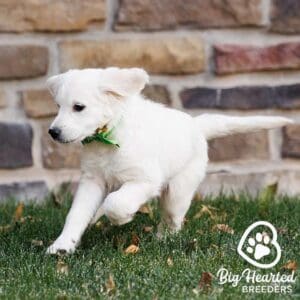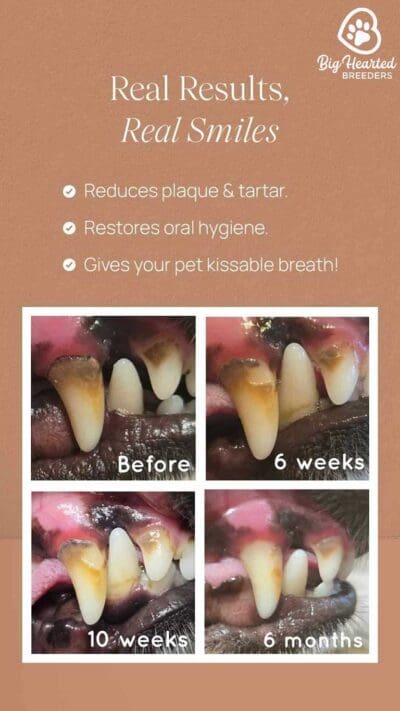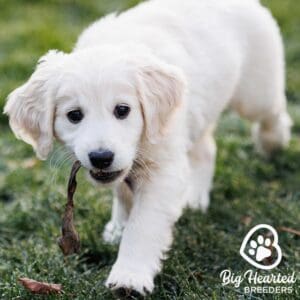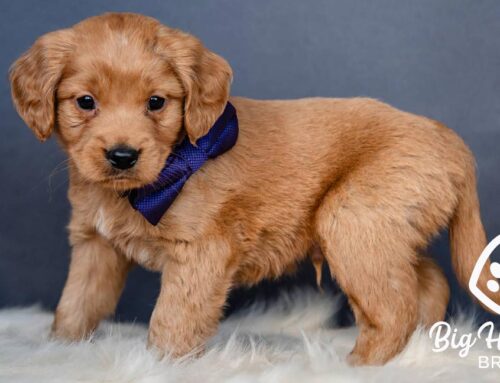Fresh Breath, Happy Pup: A Guide to Dog Dental Health
At Big Hearted Breeders, we believe in raising happy, healthy mini Golden Retrievers with an all-natural approach. Just like proper nutrition and exercise, dental health is essential for your pup’s overall well-being. Poor oral hygiene can lead to plaque buildup, gum disease, and even systemic health issues.
 Since we partner with pawTree® for premium, natural puppy care, we’ll also highlight their teeth-cleaning solutions that align with our philosophy of holistic and effective care.
Since we partner with pawTree® for premium, natural puppy care, we’ll also highlight their teeth-cleaning solutions that align with our philosophy of holistic and effective care.
This guide covers everything you need to know about dog dental health, including:
- Why dog dental care matters
- Signs of dental problems
- Natural teeth-cleaning methods
- Best pawTree® products for oral health
- Step-by-step brushing guide
- When to seek professional cleaning
- Special care for mini Golden Retrievers
 Dental disease is the #1 health problem in dogs, with over 80% showing signs by age 3. For our mini Golden Retrievers, the risk is even higher due to their compact jaws. Poor dental health can lead to:
Dental disease is the #1 health problem in dogs, with over 80% showing signs by age 3. For our mini Golden Retrievers, the risk is even higher due to their compact jaws. Poor dental health can lead to:
- Painful tooth decay and loss
- Chronic bad breath (halitosis)
- Gum infections and bleeding
- Bacteria spreading to heart, liver and kidneys
The good news? Daily dental care can prevent most problems!
The Science Behind Canine Dental Health
Understanding what happens in your dog’s mouth helps explain why dental care is so crucial:
 The Plaque-to-Tartar Timeline
The Plaque-to-Tartar Timeline
Plaque forms within hours after eating – a sticky film of bacteria
- Within 24-48 hours, plaque begins hardening into tartar
- By 3-5 days, tartar becomes cemented to teeth
- Within weeks, tartar leads to gum inflammation (gingivitis)
Left untreated, periodontal disease develops, destroying tooth support structures
Small Breed Vulnerability
Mini Golden Retrievers face greater risks because:
- Tooth crowding creates more plaque traps
- Smaller roots mean faster tooth loss once disease starts
- Shorter snouts change bite alignment, increasing wear patterns
Signs Your Dog Needs Dental Care
 Watch for these warning signs:
Watch for these warning signs:
- Bad breath (more than normal “doggy” smell)
- Yellow or brown teeth (plaque/tartar buildup)
- Red, swollen, or bleeding gums
- Excessive drooling
- Pawing at the mouth (sign of pain)
- Difficulty eating or dropping food
- Visible tooth damage or loss
- Behavioral changes (irritability, lethargy)
Pro Tip: Perform monthly mouth checks by:
- Lifting lips to examine all teeth
- Looking for red gum lines
- Checking for broken or loose teeth
- Noting any unusual growths
Natural Teeth Cleaning Methods That Work
 1. Brushing: The Gold Standard
1. Brushing: The Gold Standard
Best for: Daily maintenance
How often: 3-5 times a week (daily is ideal)
What you’ll need:
- Dog-friendly toothbrush (soft bristles or finger brush)
- Natural dog toothpaste (never human toothpaste – it’s toxic to dogs!)
Brushing Steps:
- Let your dog taste the toothpaste first
- Lift their lip gently and brush in small circles
- Focus on outer surfaces (most plaque builds here)
- Reward with praise & a treat!
Advanced Tip: For resistant dogs, try:
- Brushing while they’re relaxed after exercise
- Using flavored toothpaste they love
- Starting with just front teeth, gradually working back
 2. Dental Chews & Treats
2. Dental Chews & Treats
Best for: Dogs who hate brushing
How often: Daily
pawTree® Recommendation:
- pawTree® Plaque Control Chews – Made with natural ingredients like organic kelp to support oral health from the inside out.
How They Work:
Unlike traditional dental treats that rely on surface abrasion, pawTree® Plaque Control Chews utilize the power of Ascophyllum nodosum (a specific type of kelp) to reduce plaque and tartar through the saliva. This natural approach supports cleaner teeth, fresher breath, and healthier gums—without any mechanical scraping or abrasive texture.
- Systemic action: The kelp works through your dog’s digestive and salivary systems
- Scientifically supported: Clinical studies show a reduction in plaque and tartar buildup with consistent use
- Effortless oral care: No brushing, no scraping—just a tasty daily chew
 3. Water Additives
3. Water Additives
Best for: Easy daily protection
How often: Add to water daily
Best Practices:
- Change water daily
- Use filtered water for best results
- Introduce gradually if your dog is sensitive to changes
 4. Raw Bones & Dental Toys
4. Raw Bones & Dental Toys
Best for: Mechanical cleaning
How often: 2-3 times a week
Safe options:
- Raw, meaty bones (never cooked – they splinter!)
- Rubber chew toys with grooves
- Rope toys with dental benefits
Avoid:
- Hard nylon bones (can crack teeth)
- Antlers or hooves (too hard)
- Small toys that could be swallowed
Special Care for Mini Golden Retrievers
Our mini Golden Retrievers need extra dental attention because:
- Smaller mouths = crowded teeth (more plaque traps)
- Faster progression of dental disease
- Higher risk of tooth loss
 Our Protocol:
Our Protocol:
- Start early – Begin handling mouths at 8 weeks
- Use proper tools – Smaller finger brushes for comfort
- Combine methods – Brushing + chews + water additives
- Monitor closely – More frequent vet checks
Puppy Dental Timeline:
- 8-12 weeks: Get them used to mouth handling
- 3-6 months: Baby teeth fall out, adult teeth come in
- 6-12 months: Establish regular brushing routine
- 1 year+: Annual professional dental exams

When to See a Vet for Professional Cleaning
Even with great home care, most dogs need professional cleanings every 1-2 years. Signs it’s time:
- Severe tartar buildup (brown crust on teeth)
- Loose or broken teeth
- Bleeding gums
- Refusal to eat
- Swollen face or jaw
What to Expect:
- Pre-anesthetic bloodwork – Checks organ function
- Safe sedation – For complete cleaning
- Full oral exam – Checks all teeth and gums
- Ultrasonic scaling – Removes tartar above and below gumline
- Polishing – Smooths tooth surfaces
- Fluoride treatment – Strengthens enamel (optional)
- Dental X-rays – Reveals hidden problems (if needed)
Cost Considerations:
- Basic cleaning: $300-$500
- With extractions: $500-$1,500
- Prevention tip: Regular home care can reduce frequency of professional cleanings
FAQ: Dog Teeth Cleaning
How often should I brush my dog’s teeth?
Ideally daily, but 3-5 times a week is a good goal. Consistency matters more than perfection.
Can I use human toothpaste for my dog?
No! Human toothpaste contains xylitol, which is toxic to dogs. Always use dog-safe toothpaste.
Are dental chews enough?
They help, but brushing is best. Think of chews as a supplement, not replacement, for brushing.
My dog hates brushing. What can I do?
Try these alternatives:
- Start with just touching teeth
- Use pawTree® dental chews daily
- Add water additive to their bowl
- Try different toothpaste flavors
When should puppies start dental care?
Begin handling their mouth at 8 weeks, start brushing when adult teeth come in (around 6 months).
How can I tell if my dog has tooth pain?
Watch for:
- Dropping food while eating
- Chewing on one side only
- Pawing at face
- Unusual grumpiness
Final Thoughts
Healthy teeth mean a happier, longer life for your pup! At Big Hearted Breeders, we’re committed to raising mini Golden Retrievers with the best natural care – and that includes dental health.
For more all-natural puppy care tips, check out our pawTree® partnership page for premium products that align with our ethical breeding values.
Remember:
- Start dental care early
- Be consistent with routines
- Watch for warning signs
- Partner with your vet
Have questions? Reach out – we’re always happy to help!

Graphic of results with pawTree dental chews. These are the results of my friend’s dog.


 The Plaque-to-Tartar Timeline
The Plaque-to-Tartar Timeline 1. Brushing: The Gold Standard
1. Brushing: The Gold Standard 2. Dental Chews & Treats
2. Dental Chews & Treats 3.
3.  4. Raw Bones & Dental Toys
4. Raw Bones & Dental Toys Our Protocol
Our Protocol


